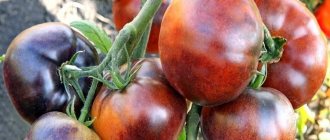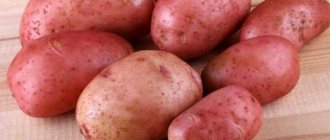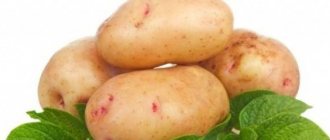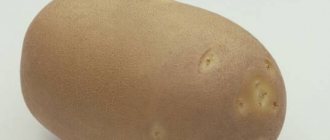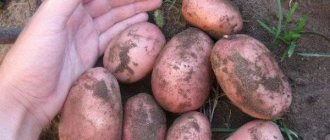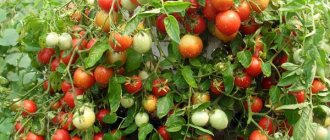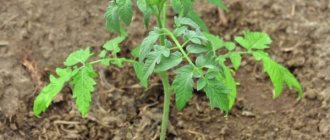The literature for gardeners is full of descriptions and photos of different varieties of potatoes. They differ in terms of ripening, shape, taste and purpose. One variety makes great mashed potatoes, the other makes french fries. There are white, purple, pink. Or, like Ivan da Marya, multi-colored.
- 4 Disease and pest control
- 5 Harvest and storage
- 6 Reviews from vegetable growers about the taste and characteristics of the variety
Origin story
The variety was brought to Russia in the 17th century from Holland.
It became widespread in the 19th century, and was officially included in the State Register only in 1995, after which it received approval for cultivation in the Central Federal District.
Ivan da Marya is widely known as Gorbachevka due to his popularity in the late 80s. In the Stavropol Territory it is called Ryabukha, in Ukraine - Fox.
Other variety names:
- Little Red Riding Hood;
- Rowanushka;
- Matryoshka;
- Drunkard.
REFERENCE : Sometimes Ivan da Marya is mistakenly identified with the Picasso variety.
Despite some external similarities, these two varieties differ in the color of the pulp, the shape of the root crop, taste characteristics and cultivation characteristics.
Potato variety Ivan da Marya
Ivan da Marya is a late-ripening potato variety (Solanum tuberosum). It was obtained as a result of amateur selection. There is evidence that it was bred in the 80-90s on the basis of the Scottish variety King Edward, using the now popular Dutch Picasso. It was widespread throughout the USSR, and even now it is not losing its position. It is distinguished by its unusual peel color. Currently considered obsolete, it is still cultivated by amateur gardeners due to its excellent taste and good yield. Susceptible to scab disease.
The variety has many synonyms, the most popular of them: Gorbachevka, Drunkard, Ryabinushka, Ryabukha, Little Red Riding Hood, Matryoshka. It should also be said that some sources claim that Picasso and Ivan da Marya are the same variety, but this is not so. They differ both in external indicators and in consumer and physiological characteristics.
The period from emergence to full ripening is 120-150 days.
The plant is quite tall, erect, compact, abundantly leafy. The leaves are large. The flowers are white or light beige. Flowering is sparse, buds often fall off.
The potato root system is powerful; one plant can produce 12-25 medium-sized tubers, weighing 60-150 grams each; there are practically no small ones. The tubers have a regular round-oval shape and a smooth surface. The peel is yellow-red in color, with a red tint predominating at the top of the tuber, which is why the variety received the nickname “Little Red Riding Hood”. When cut, the pulp is light cream in color. The eyes are small, colored red, sometimes surrounded by a red pigment spot, making the overall tuber look spotted.
The yield of the variety is quite good - 200-320 c/ha. However, this indicator is highly dependent on the type of soil, weather conditions of the season and many other factors that can affect plant development. The yield of marketable tubers is quite high, the keeping quality is also not far behind - 90%.
The taste of Ivan da Marya is excellent, according to reviews from gardeners. Despite the fact that these potatoes are inferior in their characteristics to many other modern varieties, many people continue to grow them precisely because of their excellent taste. The tubers are suitable for preparing any dishes, have low boilability, and perform best when fried. The pulp is quite crumbly, starchy, and has a very pleasant consistency. The starch content in it is noted at the level of 10-14%.
The variety is undemanding to the type of soil and can grow on any soil, but shows the best yield on slightly acidified soils. Plants are very sensitive to drought, even short-term, so you need to carefully monitor soil moisture, especially in regions with hot summers. Otherwise, planting will not cause you any additional trouble. It will be enough to carry out standard agrotechnical practices in a timely manner, and the plants will delight you with a good harvest.
This potato is susceptible to scab and is moderately resistant to leafroll virus, canker and late blight. Needs increased attention to preventive measures against these diseases. It is precisely because of its tendency to be affected by scab that gardeners are increasingly removing it from their plots, replacing it with new varieties.
According to the observations of potato growers, Ivan da Marya is prone to very rapid degeneration. And this is a big problem, because seed material needs to be replaced more often, and buying it becomes more and more difficult every year. Often, planting tubers can only be obtained from enthusiastic collectors of various very rare varieties. There is another problem associated with this nuance - often unscrupulous sellers offer a completely different variety under the guise of “Gorbachevka”. Some people do this intentionally, while others simply don’t fully understand what kind of potatoes they grow.
In conclusion, I would like to say that our hero has quite a large number of advantages, including, of course, excellent taste and good yield. But it still has significant shortcomings. However, if you are a skilled, experienced gardener who is confident in your abilities, then you can safely choose this variety for cultivation. Ivan da Marya will definitely please you with the harvest, and your neighbors will also want to have such an “exhibit” on their site.
Description of the variety
Ivan da Marya is a late-ripening variety with a ripening period of about 115-130 days, depending on weather conditions.
Bushes
The plant has an erect, high stem (up to 60cm) with a large number of leaves, so at the late stage of the growing season the bush can bend strongly towards the ground. The leaves are large and the flowers bloom profusely.
Tubers
Under each bush, up to 20 medium-sized tubers (100-120 grams) are formed with a commercial quality of 94%. Root vegetables are regular oval in shape, yellowish in color with pink eyes and inclusions. The flesh is cream-colored.
Unusual potato varieties:
Ivan da Marya has an average starch content (8-14%) and a significant amount of vitamin C.
Harvest and storage
Tubers of the Ivan da Marya variety are harvested in mid or late August. It is better to choose a sunny day with warm weather. To avoid damaging the tubers, use a pitchfork. The dug up potatoes are dried in the open air, then the crop is transferred to a cool, dry place. Before storing for long-term storage, potatoes are sorted, removing tubers that are damaged or show signs of disease.
Store potatoes in the cellar at temperatures from 0 to +2 degrees, with a humidity of 80%. Tubers are stored in cardan boxes with slots, baskets or other containers. The boxes are placed on a hill 20 cm above the floor and 30 cm away from the wall.
Peculiarities
Characteristic features of the variety:
- Grows in any climatic conditions;
- Prefers light acidified soils. On limestone soils, it gets sick and gives a weak harvest;
- Shows average performance even in shaded areas, but the best results can be achieved in a well-ventilated and sunny garden;
- When cut, the root vegetable does not darken, and when cooked, it does not fall apart.
The table shows data on the keeping quality of other potato varieties:
| Name | Variety | % |
| Nikulinsky | Late ripening | 95 |
| Cardinal | Late ripening | Over 95 |
| Rocco | Late ripening | 89 |
| Ivan da Marya | Late ripening | 90 |
| Borovichok | Early ripening | 94 |
| Bellarosa | Early ripening | 93 |
| Natasha | Early ripening | 93 |
| Ariel | Early ripening | Exceeds 90 |
| Arosa | Early ripening | 95 |
| Serpanok | Early ripening | 97 |
| Riviera | Extra early | 93 |
| Zhukovsky early | Extra early | From 92 to 96 |
| Veneta | Extra early | 87 |
| Kiranda | Extra early | 92 |
| Meteor | Extra early | More than 95 |
| Grenada | Mid-late | 97 |
| Limonka or Picasso | Mid-late | 90 |
| Mistress | Mid-late | 96 |
| Aladdin | Mid-late | 94 |
| Sifra | Mid-late | 94 |
| VR 808 | Mid-early | 95 |
| Typhoon | Mid-early | 95 |
| Lapot | Mid-early | 94 |
| Vega | Mid-early | 99 |
| Labella | Mid-early | 98 |
Diseases
Striped mosaic. The disease occurs during the development of buds. Necrotic spots appear on the lower leaves. The affected leaves fall off and the plant dies. The affected bushes cannot be treated, so they are dug up and destroyed along with the potatoes outside the site.
Curl virus. When the disease occurs, the upper side of the leaves turns yellow. Then the lower part acquires a pink tint, the leaf begins to curl along the central vein. The plate becomes brittle. Diseased bushes must be destroyed.
Fomoz. A diseased plant can be easily identified by an elongated spot that begins on the leaf petiole and then moves to the stem. The affected parts of the stem die off, and fungal spores enter the soil. Putrid dark spots appear on the tubers. For preventive purposes, planting potatoes three weeks after germination is treated with Shirlan or Thanos. During flowering of plants, the fungicide “Ridomil Gold MC” is used.
Correct fit
To collect the maximum harvest, it is necessary to carry out pre-sowing treatment:
- Sort potatoes for planting. You need to select only large and whole root vegetables, without damage to the skin or signs of disease, with a uniform, uniform color;
- Treat the germinated seeds with Agat-25K or Tabu solutions. This will protect potatoes from pests before emergence and increase overall yield by 10% or more.
REFERENCE: The optimal predecessors of Ivan da Marya are crops that acidify the soil: legumes, beets, rye. It is not advisable to plant potatoes after tomatoes, cucumbers, cabbage, and carrots.
- Prepare the soil:
- Before winter, put manure on the cleared area at the rate of 10 kg/sq.m;
- In spring, loosen and level the garden;
- If necessary, treat the soil in advance (no later than 2 weeks before planting) with systemic herbicides (Arsenal, Zenkor) or selective action (Titus, Lazurit);
- Add ash and humus to the planting holes or furrows.
Planting methods
Ivan da Marya is suitable for planting in different ways:
- Traditional. Placing seeds in planting holes with a depth of a spade bayonet;
- Comb. Planting is carried out in pre-cut ridges up to 20 cm high. The method is well suited for cold loams and peat bogs;
- Planting in narrow beds according to Mittleider;
- Planting under straw.
Planting Density
With traditional planting, the distance between bushes should be about 35cm, between rows - about 60cm.
Boarding time
Given the long growing season, Ivan da Marya is planted as early as possible - as soon as the earth warms up to 10*C. Depending on the climate and latitude, this period ranges from the 20th of April to the first of May.
Landing Features
Potatoes of the “Ivan da Marya” variety are planted in late April or before May 10. Choose an open, sunny place for planting with light fertile soil. The soil should be well warmed up and slightly moist. The holes should be 10-12 cm deep. As an additional source of nutrition and protection from wireworms, a handful of ash or onion peels is poured into the hole. The size between the holes is 30-35 cm, in the row spacing 70 cm.
Care
The main rules of care, the observance of which will ensure high yields:
- Loosen the soil 7 days after planting;
- Spray emerging plants with growth stimulants Epin or Obereg, and after a week carry out another treatment with Gibbor-M or Ovary;
- Constantly hill up young shoots;
- Collect Colorado potato beetles in a timely manner, or, if the area is large, use insecticides at the 2nd stage of larval growth.
IMPORTANT: Ideal yield indicators can be achieved with drip irrigation of potatoes.
If it is not possible to organize drip irrigation, the bushes should be watered in the traditional way at least 6 times a season, depending on the weather. In this case, the soil must be moistened to a depth of 50-60 cm.
Features of care
If a vegetable grower wants a good harvest, then you need to follow the care instructions. The plant needs timely watering and feeding. To do this, before the buds appear, a week after planting, shallow loosening is carried out and weeds are removed with a flat cutter. During the flowering period, the vegetable grower hills the crop (bush height 20 cm), and also mulches the rows with straw or previously mown grass. To sanctify the stems evenly, they are spread in different directions.
For the southern regions, this is a mandatory procedure, since this is one of the factors affecting yield. Tubers will be poorly formed if they are not watered on time. Before flowering begins and in the absence of rain, watering is carried out once a week with approximately 10 liters of water per m2. During flowering, this figure must be increased by 2 or 3 times. After flowering, additionally irrigate the soil once every 2 weeks. Water can be supplied either directly under the bush or into grooves that run parallel to the row. After 1-2 days you need to loosen. You can understand that potatoes lack moisture by looking at the above-ground part of the plant; if it withers for no apparent reason, then this is a direct reference to a lack of water. The procedure is recommended to be carried out after sunset in the evening hours, this avoids burns on the plant.
Properly selected and timely applied fertilizing not only increases productivity, but also in some way accelerates the process of growth and further maturation. For good development, you must do the following:
- Spray the tops before the buds appear with Epin-Extra. To save time, you can combine watering and fertilizing with mullein (1 kg of manure per 10-15 liters of water).
- During budding, fertilize with green fertilizer (proportion 2:10). For 1 m of planting there is 1 liter. Another alternative feeding option: wood ash and superphosphate, 3-4 tbsp. spoons of each per 10 -15 liters of water. As soon as the period of mass flowering begins, the tops are irrigated with a special preparation “Ovary”.
- After potato flowering, fertilizing is not carried out.
Pest treatment
In the description, among the shortcomings it was stated that it is subject to attack by insects. To prevent them from damaging the tops and root crops, it is necessary to treat them with chemicals. The most dangerous pests for crops:
It is not advisable to spray adult plants, since during watering or rain the drug will be washed off, the procedure must be systematically repeated. And this is unsafe for health, since the drugs contain strong chemicals.
Diseases and pests
Ivan da Marya is highly resistant to such diseases:
- Late blight;
- Malignant tumors;
- Curling of leaves;
- Viruses.
Most often, plants suffer from scab and the Colorado potato beetle.
The table presents data on starch content in different varieties:
| Name | Variety | % |
| Nikulinsky | Late ripening | From 12 to 21 |
| Cardinal | Late ripening | 15 |
| Rocco | Late ripening | 16 |
| Ivan da Marya | Late ripening | From 8 to 14 |
| Asterix | Late ripening | 17 |
| Borovichok | Early ripening | From 13 to 17 |
| Elmundo | Early ripening | From 11 to 14 |
| Felox | Early ripening | 16-17 |
| Bellarosa | Early ripening | 12 to 16 |
| Natasha | Early ripening | From 12 to 14 |
| Forty days | Extra early | From 11 to 15 |
| Karatop | Extra early | From 10.5 to 15 |
| Riviera | Extra early | 19,6 |
| Zhukovsky early | Extra early | From 10 to 12 |
| Farmer | Extra early | 12 |
| Crane | Mid-late | 14-19 |
| Sorcerer | Mid-late | From 12 to 15 |
| Mozart | Mid-late | No more than 20 |
| Grenada | Mid-late | From 10 to 17 |
| Melody | Mid-late | From 11 to 17 |
| Yanka | Mid-early | 14,8-15,4 |
| Giant | Mid-early | 16-19 |
| Tuscany | Mid-early | From 12 to 14 |
| Purple Haze | Mid-early | 14,4-17,2 |
| Openwork | Mid-early | From 14 to 16 |
Scab
It appears in the form of cracks, warts, rough crusts on tubers, as a result of which the germination of potatoes is greatly reduced.
The variety is prone to degeneration, so it is necessary to update the planting material every 2 years.
Fighting methods:
- Pre-sowing soil treatment with ammonium sulfate at the rate of 30 g/sq.m;
- Add 2 g of manganese sulfate to the wells;
- Sufficient soil irrigation.
Colorado beetle
Under potato leaves, the beetle lays eggs, from which larvae subsequently hatch. At the 1st growth phase they eat the lower part of the leaf, at the 2nd - the entire leaf, at 3-4 they spread throughout the entire bush.
We invite you to familiarize yourself with potato varieties that have different ripening periods:
| Late ripening | Early ripening | Very early | Mid-late | Mid-early |
| Nikulinsky | Borovichok | Forty days | Crane | Yanka |
| Cardinal | Elmundo | Karatop | Sorcerer | Giant |
| Rocco | Felox | Riviera | Mozart | Tuscany |
| Kiwi | Bellarosa | Zhukovsky early | Grenada | Purple Haze |
| Ivan da Marya | Natasha | Farmer | Melody | Openwork |
| Picasso | Ariel | Minerva | Margarita | Santana |
| Asterix | Queen Anne | Veneta | Ramona | Desiree |
| Slav | Arosa | Kiranda | Dolphin | Lady Claire |
Fighting methods:
- Joint planting with marigolds, garlic, calendula;
- Collection of larvae and beetles by hand;
- Spraying with folk remedies: infusion of garlic, wormwood, ash;
- Application of insecticides: Vir, Aktara, Bitoxibacillin.
Advantages and disadvantages
The advantage of the variety is the leveled surface of the root crops and the possibility of long-term storage. The variety “Ivan da Marya” tolerates drought well and is resistant to major diseases. When cooked, potatoes have excellent taste.
The disadvantage of the variety is that it is damaged by the Colorado potato beetle, and the tubers gradually degenerate, so every 4-5 years the seed material is replaced with new one.
Reviews about the variety
Reviews about the variety vary.
Some say that the only advantage is its pleasant taste. Constantly suffers from scab and late blight, the harvest is small - tubers are 1-2 cm long. The tops are really beautiful and tall.
Others say that Gorbachevka is a classic! They have been growing them in the country for ten years in a row without any degeneration. Water once a week. For beetles they are sprayed 2 times during the summer. Before planting, chicken manure is added. From 2 acres to 30-40 buckets. Very tasty potatoes.
The most productive potato varieties:
Plant care
For full development and the formation of large volumes of crops, potatoes require breathable soil. With traditional planting, plant care involves the following steps.
Loosening and hilling
Hilling and loosening allow the potatoes to “breathe” and develop well
5–6 days after planting, they begin to loosen the soil, removing weeds. The bushes are also hilled several times throughout the season. This can be done with a hand hoe or chopper. The work is carried out after watering or precipitation.
The number of hillings depends on weather conditions. If there is a possibility of frost returning, the procedure is carried out immediately upon the formation of seedlings, which are completely covered with soil. At the initial stage of development, potatoes are quite sensitive to low temperatures. At temperatures from -1°C to -3°C, the tops become black.
If frost is not expected, the bushes are earthed up for the first time when the stems reach 20 cm. At the same time, a mound is formed around the plant, using soil from the rows. After 15–20 days, the procedure is repeated. To ensure uniform illumination of the stems by the sun, they should be spread apart.
Fertilizer application
Fertilizing is an integral measure for caring for potatoes.
The plant uses a lot of nutrients to form tubers.
Therefore, proper attention should be paid to feeding. The compositions are applied into grooves dug at a distance of 15 cm from the row
Table: features of potato fertilizer
| Type of feeding | Application stage | Fertilizers |
| Root | A month after landing | 20 g of urea, 0.5 liters of bird droppings or mullein per 10 liters of water. |
| At the stage of bud formation | 200 g of ash, 40–50 potassium sulfate per bucket of water. | |
| At the flowering stage | 15 g of nitrophoska, 30–40 g of superphosphate per 10 l. The consumption of nutrient solutions is 0.5 l per plant. | |
| Foliar | At the end of flowering | Spraying bushes with superphosphate solution (100 g per 10 liters of water - consumption per 10 m2) |
Watering
It is advisable to water the potatoes in the evening hours
Water the potatoes three times a season. But you should pay attention to weather conditions. If there is frequent precipitation, it is recommended to postpone watering until the flowering stage. Water can be supplied under bushes or into grooves along the rows. The next day, loosening should be done. You can make sure that the potatoes receive enough moisture by checking the condition of the tops. Wilting of the above-ground part of the plant indicates a lack of watering. Also note that it is best to carry out the procedure in the evening, after sunset. This will help avoid burns.
Table: according to potato watering rates
| Watering time | Water consumption | |
| When watering under a bush | When using furrows | |
| After germination | 3 l per plant | 10–15 l per 1 m2 |
| During the formation of buds | ||
| After the inflorescences fall |

